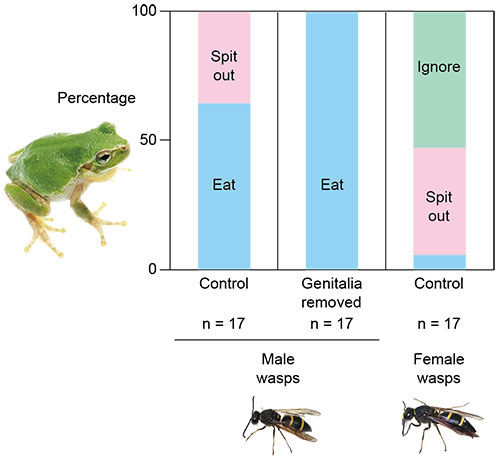Predation can lead to the evolution of defensive devices in prey animals. Genitalia, which are used for mating between males and females, have rarely been considered to function as an important anti-predator defense. Now, research has documented the first evidence for defensive roles of male genitalia in wasps.
Kobe University ecologists Shinji Sugiura and Misaki Tsujii found that males of the mason wasp Anterhynchium gibbifrons (Hymenoptera: Vespidae: Eumeninae; Fig. 1) use their sharp genital spines as "stings" to counterattack predators and their laboratory experiments suggest that male genitalia play an important role in preventing predators from swallowing male wasps. Their research appears in the 19 December 2022 issue of Current Biology.

Fig. 1. The mason wasp Anterhynchium gibbifrons.
(A) An adult male visiting a Cayratia japonica flower. (B) The pseudo-stings (parameral spines; blue arrows) and aedeagus (red arrow) of an adult male. (C) The sting (blue arrow) of an adult female. Credit: Shinji Sugiura

Fig. 2. Behavioral responses of the tree frog Dryophytes japonica to males and females of the mason wasp Anterhynchium gibbifrons.
"Control" and "genitalia removed" indicate the male wasps that were able and unable to sting, respectively. Credit: Shinji Sugiura
Wasps and bees (Insecta: Hymenoptera) use venomous stings to defend themselves and their colonies against attackers. Because they have evolved venomous stings from ovipositors, their males, which lack ovipositors, were believed harmless. However, Misaki Tsujii was accidentally stung by an adult male A. gibbifrons while investigating the life history of the mason wasp species. Surprisingly, the male "sting" caused a pricking pain. The male wasp used a pair of sharp spines in the genitalia (Fig. 1B) to pierce her finger. Although the male behavior is similar to the female stinging behavior (Fig. 1C; see Video), the genital spines did not appear to emit venom, unlike in the female. Misaki Tsujii also observed that male wasps did not use their genital spines to mate with female wasps under laboratory conditions. Based on her experience and observations, Shinji Sugiura hypothesized that the male genitalia of A. gibbifrons function as an anti-predator defense. To test his hypothesis, Sugiura experimentally provided male wasps to potential predators (a pond frog Pelophylax nigromaculatus and a tree frog Dryophytes japonica) under laboratory conditions. All of the pond frogs (n = 17) attacked and ate the male wasps. Although all of the tree frogs (n = 17) attacked the male wasps, 35.3% of the tree frogs rejected the male wasps (Fig. 2; see Video). The male wasps stung or bit the tree frogs while being attacked. Tree frogs were also provided male wasps from which the genitalia had been removed. All of these tree frogs (n = 17) ate the males. Thus, male wasps can use their genitalia to counterattack predators and prevent the predators from swallowing them.
To compare the anti-predator defense between male and female wasps, Sugiura also provided female wasps to pond and tree frogs. All of the pond frogs (n = 17) attacked and ate the female wasps, while 47.1% of tree frogs (n = 17) attacked the female wasps (Fig. 2); however, 87.5% ultimately rejected them (Fig. 2). Therefore, female wasps have more effective defenses against tree frogs than male wasps do, although the female defense is not effective for pond frogs.
In the experiments, the wasps did not seriously harm the frogs and the same wasps and frogs were not used repeatedly.
Because male genital spines (called "pseudo-stings") are found in some wasp families (e.g., Mutillidae and Vespidae), their defensive roles will likely be found in many wasp species in which the males have pseudo-stings.
The genitalia of male animals have frequently been studied in terms of conspecific interactions between males and females but rarely in terms of prey-predator interactions. This study highlights the significance of male genitalia as an anti-predator defense and opens a new perspective for understanding the ecological role of male genitalia in animals.
Journal Information
- Title
- "Male wasp genitalia as an anti-predator defense"
- DOI:10.1016/j.cub.2022.11.030
- Authors
-
- Shinji Sugiura
- Misaki Tsujii
- Journal
- Current Biology






